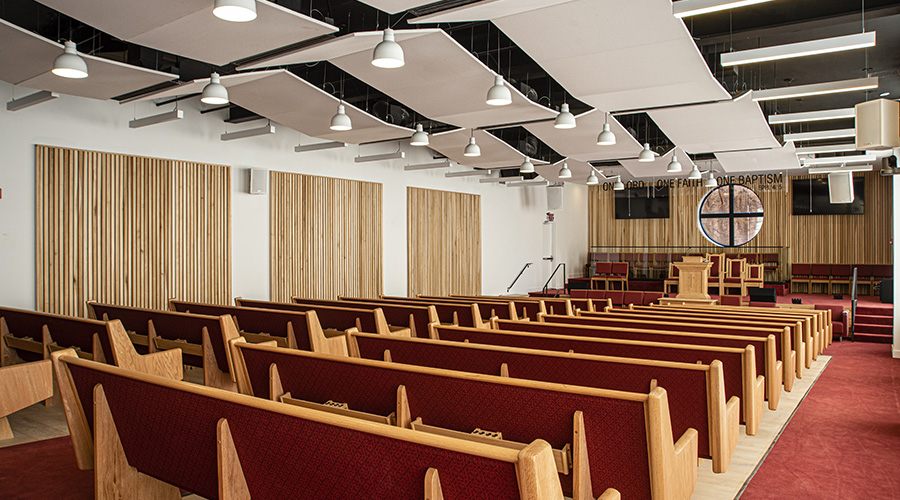Hidden Hazard
Abandoned cable in plenum space may be out of sight, but it shouldn’t be out of mind. In a fire, it could be dangerous
Thanks to computers and modern communications equipment, offices today are more productive and often handle complex data in seconds. However, tucked into the ceiling plenum above the unsuspecting heads of busy workers and corporate executives lurks a hidden hazard which can produce toxic gases under fire conditions. That hazard is communications cabling. More specifically, it is the plastic that insulates and jackets the copper wiring inside that poses a problem.
According to industry estimates, approximately 84 billion feet of communications cabling exists in ceiling plenums in the United States. Much of it is abandoned, replaced by newer, faster-transmitting cables. This abandoned cabling, snaking through the air plenums of the building’s HVAC system, adds significantly to the fire load of the building. When the average building is recabled, the existing cable generally is left in place, so the problem keeps building.
Fire Safety
The fire concern is not the 22- or 24-gauge copper, but the plastic cable insulation and jacketing. A plenum that is packed with cabling can create the same fuel load as gasoline, says John Michlovic, manager of technical services and marketing for H.H. Robertson Floor Systems. But fire is not the only problem. The plastics also release toxic smoke in a fire. The fire doesn’t necessarily ignite the cabling jackets immediately, but the heat can cause it to release clear or white gases that are nearly undetectable. These gases can be blinding or halt the respiratory system.
“Plenum rated cabling will start burning in 35 to 40 seconds to a couple of minutes,” says Michlovic. “Currently, there’s no smoke-developed criteria for plenum-rated cable, no fuel load standard, no toxicity standard and no acid level requirements.”
What’s burning? “Most of the weight in abandoned cabling is plastic,” says Frank Peri, president of Communications Design Corporation. Peri estimates 1,000 feet of four-pair unshielded twisted pair cable weighs about 30 pounds — 10 pounds of copper and 20 pounds of plastic jacketing and insulation.
“When those cables are installed in a plenum, exposure to airflow makes the risk of fire and smoke spread especially dangerous,” says Simone Genna, U.S. market segment leader for DuPont Cabling Solutions.
Insulated, jacketed cabling releases gases that, when they come in contact with any moisture, including humidity, form hydrofluoric acid, says consultant Frank Bisbee of Wireville.com. “That acid is so strong that it eats glass.”
Another health issue involved in abandoned cabling is the lead content found in plenum cabling jacketed with fire resistant polyvinyl chloride, says Bisbee. PVC is flexible because it contains lead stabilizers and plasticizers.
“Often, the manufacturers put in lead — 7 to 10 percent by weight,” says Bisbee. “It doesn’t cost more and when lead gets hot it acts like a lubricant.” But as PVC breaks down, it can release lead dust, says Bisbee. “That lead dust can be blowing around the building and raining in amounts reaching 25,000 parts per million, because PVC breaks down pretty fast.” The Environmental Protection Agency limits lead exposure to 220 parts per million.
Code Requirements
The problem of abandoned cabling is serious but continues to be overlooked, and codes are just beginning to address the problem.
Because abandoned cable represents combustible loading, the National Electrical Code (NEC) in its 2002 and 2005 editions requires the removal of accessible portions, says Mark Earley, assistant vice president and chief electrical engineer for the National Fire Protection Association (NFPA).
“In general, the NEC defines abandoned cable as installed cable that is not terminated at both ends at equipment other than a connector and not identified for future use with a tag,” says Genna. “Within those articles, subsections related to spread of fire or products of combustion say, in effect, that the accessible portion of abandoned communications cables shall not be permitted to remain.This is true in both the 2002 and 2005 editions of the NEC.”
Other codes or standards besides NEC also may apply to abandoned cable. For example, NFPA 90A, the standard for installation of air conditioning and ventilation systems, does set some parameters that are to be met in plenum spaces. NFPA 76 covers fire protection of telecommunication facilities and NFPA 75 is the standard for electronic computer and data processing equipment. But the one that is most likely to result in removing this hidden hazard remains the electrical code.
Exceptions
Under NEC’s newer versions, the accessible portions of abandoned cable must be removed with few exceptions. If they are tagged for future use, for example, they can remain. However, Earley admits the code is not that specific on what constitutes appropriate tagging.
Abandoned cable also may be left in place if it cannot be removed without causing “building structural issues,” says Earley.
Whether unused cable needs to be removed depends on the code enforced in the local community. Even if appropriate NEC codes are embraced by a particular community, enforcement may be lax, says Bisbee.
“One reason the codes aren’t enforced on this matter is that cities often are still wrestling with clearing their properties of abandoned cable,” says Bisbee. “Pulling abandoned cable from plenums is extremely labor-intensive. Often the cabling gets interlaced and wound around each other so there’s a good possibility you could pull out the working one, too.”
So, even if the area is covered by the appropriate NEC code editions, often the only time abandoned cable will be addressed is during a major wall-to-wall renovation. At that time, electrical inspectors are clearing new wiring and reissuing or denying certificates of occupancy.
But the concern for the potential hazards abandoned cabling presents is growing. A number of municipalities are beginning to address the abandoned cable issue, including Atlanta, Denver, San Francisco, Los Angeles and Seattle.
Another issue that clouds the abandoned cable controversy is responsibility. Is the building owner responsible for removing abandoned cable? Is it the tenant who abandoned the cabling? Who is expected to pay to correct this growing hazard? The experts agree that no one really knows yet.
“NEC establishes the performance issue,” says Earley. “It tells what has to be removed. But the code does not assign responsibility for that removal. Whether the contractor, the building owner or someone else removes the cabling is not a code issue. The inspector for the jurisdiction will indicate what needs to be removed before the building can pass its electrical inspection.”
“Best practice for owners is to make sure they have a thorough, professional assessment to give them a good understanding of what the current state of liability is and clean up that space as budgets and moves/adds/changes allow,” says Genna. “From that point forward, leases can include verbiage that requires the tenants to deal with future cabling.
“Once abandoned cable is removed, building owners must also consider options for environmentally responsible disposal,” says Genna. “Some of the plastics, as well as the metal, in cabling materials can be reclaimed for reuse, thereby reducing the large amount of plastics that are disposed of in landfills or incinerated.”
Leased Space Issues
Multi-tenant property management, vendor operations and tenant turnover are challenging the real estate industry to be specific about who is responsible for what, when and how.
Both the Building Owners and Managers Association (BOMA) International and the National Association of Industrial and Office Parks are working on lease rewrites to address the abandoned cable issue, says Bisbee.
In a typical high rise office, the building owner probably will be responsible for backbone network cabling, which is usually installed in vertical risers to tenant office suites. The network distribution cable from the tenant’s communication room to its workstations, however, may be the tenant’s responsibility, depending on how the lease is written.
“Until recently, it was not common for owners to explicitly require the removal of abandoned cable of their tenants,” says Genna. “It is likely that disputes between tenants and owners over responsibility for cable removal will become more common, and that new leases will have removal requirements.”
Peri believes another way to approach the issue of abandoned cable is for facility executives and building owners to consider cabling an asset. “You can see cable as trash or treasure. If you see it as a building utility that you supply and charge your tenants for, then you have a revenue stream.”
When cable needs servicing, the building owner or property manager would provide that maintenance or improvement. “It’s not being done today, but I think it could be built into the lease or offered as an add-on service,” Peri says.
Although there is a cost to removing abandoned cable, Michlovic believes the emphasis should not be on monetary considerations. “Abandoned cable really is a life safety issue and it needs to be removed.”
CODES CATCHING UP
Growth Of A Problem
No one anticipated the volume of abandoned cable that is found in a typical office building today. Technology drove cabling to change as processing speeds increased and there was more demand to move information faster. Category 3 cabling was followed by Category 5 cabling, then Category 5e, and so on. Because there was no rule saying that the old cable needed to be removed, often it was simply left in place.
By the time the codes began catching up to the problem, so much cable was tangled in the average office building’s plenum that no one really wanted to address it. In fact, buildings in localities still using the 1999 edition of the National Electrical Code are not required to remove unused cabling, no matter how much it may be interrupting the flow of air in HVAC plenum spaces or weighing down suspended ceilings.
— Rita Tatum
|
Rita Tatum, a contributing editor for Building Operating Management, has more than 25 years of experience covering facility design and technology.
Related Topics:











